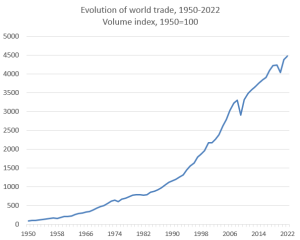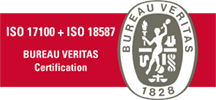Letting the domestic market be the only focus of a company’s business activities is a strategy that may seem safe, but is limited. At first glance it may seem that the domestic market offers abundant opportunities, but the truth is that confining yourself exclusively to your local market can subject your business to the unforeseen events in your local context. Therefore, it becomes not only beneficial, but essential for the survival and sustained growth of any company, to extend your horizons and embrace the dynamics of international markets.
In 2022, international trade represented 25% of European Union’s Gross Domestic Product (GDP), increasingly relevant to the Union’s economy. This data underlines the Union’s pivotal position on the world stage, with a 17% share of global exports in 2021, considering only exclusive transactions with markets outside the EU. Considering the linguistic diversity inherent to the European continent, with 24 official languages, if we add to these the various languages with non-European origins, spoken by an additional two billion people around the world, then the importance of clear and effective communication becomes all too evident.
At first glance, this linguistic diversity may seem like an insurmountable obstacle. However, by partnering with the right translation company, with the right tools and an effective translation and localisation strategies, this challenge becomes an opportunity. A close collaboration with the appropriate translation company is key when it comes to leaving your mark on/entering international markets. It can even give your company a competitive edge over your competition. By doing so, you can not only present your value proposition to a wider customer base, but also chart the path for your business’ overall growth.
Translation transforms barriers into bridges that lead to global success. M21Global is the ideal translation company to guide you on this journey.
Opportunity knocks
Data from the World Trade Organisation shows robust growth in global trade. World exports of manufactured goods have increased by approximately 35% over the last decade, having more than quadrupled since the year 2000.

The expansion of global trade is driven by robust economic growth worldwide, revealing a growing tendency for business activities to transcend national borders.
This business globalisation highlights the importance of effective communication in multiple languages, the imperative need for qualified translation services is clear for those companies that aspire to venture into markets outside their national borders. Regardless of the language currently used in your operations, your future customers are likely to communicate in a different language, placing translation at the heart of your international expansion strategy.
In addition to this linguistic challenge, integration into new markets entails an encounter with different cultures, where practices and perceptions can differ significantly from your own. These cultural differences directly influence the demand for your products or services and affect the way you should approach and communicate with your potential customers. Understanding and adapting to these cultural aspects is as vital as the linguistic translation itself, determining the success of your communication and, by extension, your business expansion.
The Internet plays a crucial role as a meeting point between organisations and potential international clients, and is often the stage where translation and localisation challenges manifest themselves. The decision to expand into new markets is influenced by the translation challenges that each market presents. Translating content into the 10 most spoken languages in the world would only reach around 67% of the world population, highlighting the limitations of monolingual approaches.
Contrary to the notion that translation into multiple languages is not necessary due to the prevalence of bilingual or multilingual users, with English often serving as a second language, the reality of the digital market suggests otherwise.
With a global population of Internet users estimated at 5.5 billion, if we consider the five most spoken languages globally (English, Mandarin, Hindi, Spanish and French), it would only be possible to cover 74% of Internet users. This scenario underlines the importance of a multilingual communication strategy, illustrated by the distribution percentage of speakers by language and the significant impact on accessibility to the global market.
In short, if you keep your content in only one language, these are the numbers of users you are leaving to the competition (in millions):
| Ranking | Language | Total Speakers | % global market | Native speakers | % global market |
|---|---|---|---|---|---|
| 1 | English | 1 456 | 26 % | 380 | 7 % |
| 2 | Mandarin Chinese | 1 138 | 21 % | 939 | 17 % |
| 3 | Hindi | 610 | 11 % | 345 | 6 % |
| 4 | Spanish | 559 | 10 % | 485 | 9 % |
| 5 | French | 310 | 6 % | 81 | 1 % |
| 6 | Arabic | 274 | 5 % | 77 | 1 % |
| 7 | Bengali | 273 | 5 % | 234 | 4 % |
| 8 | Portuguese | 264 | 5 % | 236 | 4 % |
| 9 | Russian | 255 | 5 % | 147 | 3 % |
| 10 | Urdu | 232 | 4 % | 71 | 1 % |
In addition, the specificity of each market also plays a crucial role in defining the localisation strategy. For example, in Indonesia, which is projected to be the world’s eighth largest economy by 2050, the relevance of communicating in the local language is evident. Although a third of Indonesians speak English, the vast majority of the population remains more accessible through the Indonesian language, spoken by 210 million people. This example highlights the need to adapt the message not only in linguistic terms, but also considering the cultural complexity of the target country.
Recent studies by CSA Research corroborate the importance of linguistic localisation, revealing that 76% of online consumers prefer products with information in their native language, and that 40% of these consumers avoid shopping on websites that do not offer information in their language. This trend is reinforced by another CSA report , which indicates that 75% of consumers are more likely to purchase products and services with information in their native language, while 60% rarely or never buy from English-only websites.
The relevance of a communication strategy adapted to the target market is also highlighted by Alexika; 65% of consumers prefer to make purchases in their own language .
This data reflects the existence of a greater propensity of consumers to purchase products and services when faced with materials adapted to their linguistic and cultural contexts.
Linguistic and cultural diversity represents both a challenge and an unprecedented opportunity. The key to turning these challenges into opportunities lies in the ability to communicate effectively in multiple languages, adapting to the specific cultural nuances of each market, revealing the importance of partnering with the right translation company.
M21Global emerges as the ideal choice for companies looking not only to overcome language barriers, but also to establish authentic and effective communication with international markets. Understanding the complexities inherent to translation and localisation, M21Global as a translation company is equipped to provide tailor-made solutions, ensuring that your message is delivered in a clear and culturally relevant way to your target audience.
Successfully achieving the global expansion of your company requires more than simply translating words from one language to another; it’s about creating bridges of understanding and trust between cultures. By choosing M21Global as your partner, you ensure not only access to international markets, but also a competitive advantage that positions your company for long-term sustainable growth. M21Global is the right translation company that can help your company overcome these challenges, guiding it towards international success.

